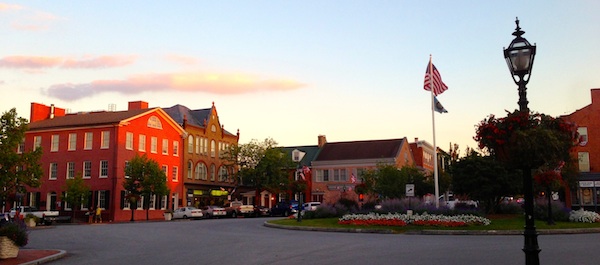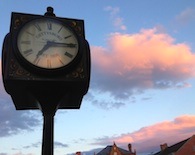
Millions of people visit the Gettysburg National Military Park each year, but if they don’t take time to explore the town of Gettysburg they are missing an important part of the experience.
On August 4, 2014, HistoryNet‘s senior editor, Gerald Swick, spoke with Cary Gregory, a man with a mission regarding the town of Gettysburg, Pennsylvania.
HistoryNet: Touring the battlefield at Gettysburg is unforgettable, and the new visitor center the Park Service opened a few years ago makes it even more amazing. But you’ve started something called Great Gettysburg Addresses to let visitors know they are missing part of the Gettysburg experience if they only go to the battlefield. What is Great Gettysburg Addresses?
Cary Gregory: To boil it down to one sentence, our tag line is “Come for the history … Stay for the hospitality.” That’s what makes this place unique—the friendly people, the historic sites, the unique things you can do here. We want to make people aware of all the town has to offer. I decided to put the flag up and see if anyone salutes.
I wanted an unbiased look at Gettysburg tourism, so I found an MBA class out of Fordham University in New York that was looking for a project, and I asked them to do an independent study. They found that most people who come to Gettysburg are passing through on the way to somewhere else, like New York or Philadelphia. The average stay is a day and a half. That’s barely time to see the battlefield. In Gettysburg, if you don’t see it, you don’t do it, so Great Gettysburg Addresses lets people know what the things are that make Gettysburg unique—the Segway Tours (that use Segway Personal Transporters to tour the battlefield with a licensed guide), the Dobbin House (Tavern), Mr. G’s Old Fashioned Ice Cream, and so on—to let them know they have a lot of choices of things to see and do when they are planning to visit.
HN: How many people visit Gettysburg in a year, on average?
CG: Gettysburg visitation had its heyday in the 1960s and ’70s, based on National Park Service data—anywhere from 2-6 million visitors a year. Today we see about a million. There has been ebb and flow over the years. During the energy crisis of the 1970s, visitation dropped. In ’93 we started to see a resurgence thanks to the Gettysburg movie. It had a long tail, and we continued to see increased visitation up to about 2007–2008. In 2009 there was another sharp drop off; we went from 1.5 million visitors a year to roughly 1 million. That was when the new visitor center opened, and you would expect to see traffic pick up because of that, but the opposite happened. Probably, the condition of the economy then had a lot to do with that drop off.
 But if you are interested in the Battle of Gettysburg, you need to be here to really experience it. You have to walk the battlefield, touch it, smell it, to understand it. You want to talk about leadership, there’s some great lessons out there. Talk about courage? There are some great lessons. There is so much nuance, so much still being discovered.
But if you are interested in the Battle of Gettysburg, you need to be here to really experience it. You have to walk the battlefield, touch it, smell it, to understand it. You want to talk about leadership, there’s some great lessons out there. Talk about courage? There are some great lessons. There is so much nuance, so much still being discovered.
I want to grow an awareness for what makes this place special. In my opinion, it is one of best-preserved national parks anywhere in the U.S. You can go out and look at a viewscape here and see what the men had to do who fought here in 1863. People ask, “Why didn’t they shoot at the enemy (at certain spots on the field)?” Well, because they couldn’t see them. You have to be here, see the folds in the landscape, and then you understand.
I’m a business consultant, and I travel a great deal. I was down in Colombia—specifically, Bogota—and I went past a school named the Abraham Lincoln Elementary School. It was written in English on the school and the side of school buses. I did a double take to make sure I was reading that right. Once, when I was in the Philippines, a Filipino girl heard I was from Gettysburg, and she recited the entire Gettysburg Address to me in English. Gettysburg is known all over the world. All the more reason I feel we need to increase what we do here.
HN: Are many buildings still standing in the town that were there when the bullets were flying?
CG: Yeah, actually, there are a lot. I was wondering myself exactly how many. The Gettysburg Times just today published a 36-page piece on Gettysburg Addresses that we helped underwrite. It highlights more than 30 buildings in town that were here during the battle—the train station where Lincoln arrived in November 1863 when he delivered his Gettysburg Address, the Willis House where he stayed, the Lutheran Seminary cupola where John Buford stood to survey the ground before the battle, the Jennie Wade House. It’s not unusual to find embedded bullets and cannonballs in buildings around the town. That amazes people, to see a 150-year-old cannonball still stuck in the wall of a brick building. You can walk the streets and imagine the firestorm that would have been coming at you from sharpshooters in the town. Other than Williamsburg, I’m not sure where else you could go in the United States to see so many structures that are still as they were when a town’s history was being made.
HN: Did you grow up in Gettysburg?
CG: We moved here in 2007. The plan was that I was going to retire. Apparently, I’m not very good at retiring. I do business consulting for a lot of major companies, so I travel a lot domestically and internationally.
I was corporate-side for 25 years. I got to do a lot of interesting and exciting things, but we moved a lot. By the time my daughter was seven she had lived in four states; I said, “Maybe its time to pick a place.” We had a second home here—most people have second homes in the mountains or at the beach; we had one in Gettysburg. My wife and I were talking, and she said, “You know, the people in Gettysburg are very friendly and there’s a lot to do there.”
I grew up in New Jersey. All my grandparents and my father were born in Greece. He immigrated here through Ellis Island in 1922. I like to kid him that he is my true American hero: he survived the Depression, fought in World War II, then came home and went to school on the GI Bill.
My first visit to Gettysburg was when I was in college at The Ohio State University in Columbus. My parents and I decided to meet there because it was half way. Since then I’ve always found a way to get here once or twice a year. When I was working in Parkersburg, West Virginia, for example, I had a client located north of here; I’d always stop in Gettysburg on the way. It was the same thing when I had a client in Philadelphia. I think that says a lot about the mystique of Gettysburg.
On one of my trips here in 2007, I did a drop-in at the elementary school because we were thinking of moving here. The principal dropped what he was doing and spent an hour taking me around, introducing me to teachers. He knows every kid by name.
HN: What are you doing to reach Gettysburg visitors and tell them about the town itself?
CG: We put a strategy together and we work it. We take a four-prong approach: print advertising, digital, social media, and consumer direct. On our website, GreatGetttysburgAddresses.com, we have an interactive map showing participating businesses. Mouse over a location, and it shows you the business name, address, email address, and their Facebook page if they have one. If you want to get information while you are here, you can pull it up on your phone.
We also have a very active Facebook community with well over 10,000 fans. We’ll post something interesting about Gettysburg, such as information about one of the buildings here. We have Pintrest and YouTube pages, but we’re still in the early development there. We’ll do an email blast with information on interesting things that are going on—the 151th anniversary reenactment earlier this year, for example. We also have over 20,000 brochures in over 100 locations, including all the inbound interstate rest stops.
HN: Is this part of the tourism bureau’s activities? How is Great Gettysburg Addresses funded?
CG: The good news is, there are no tax dollars at work. The bad news for me is, there are no tax dollars at work. We are completely privately held; we don’t use any public funds, we’re not part of any tourism or government bureau. This way we don’t have a bureaucracy, and there are no politics involved. It’s very simple—I pay all the bills. We formed a second company, GettysGear, which basically funds the operation. We try to sell reasonably priced eclectic things you’re not going to find anywhere else, like our Guardians of Gettysburg statues you can take home or cigars from the Great Gettysburg Tobacco Company, the oldest operating cigar factory in America—which coincidentally was founded here in 1863. We aren’t bashful about letting people know about GettysGear, but we don’t bash people over the head with it, either; the more people we reach, the more outreach we can do.
HN: Thank you for taking time to talk with HistoryNet. Is there anything you’d like to add in closing?
CG: What happened at Gettysburg in July and November of 1863 determined not only the future of what we would be as a nation, it affected what the world would become. I’d like to circle back to our tag line, “Come for the history … Stay for the hospitality.” When you look at a map of Gettysburg, whether it’s a map from 1863 or from 2014, you see this series of roads that converge here. That was certainly a factor in why the armies met here. Those roads still lead to Gettysburg. I’d like to get more people using them to come here. Any day we can do something that accomplishes that goal, that’s a good day
[nggallery id=158]




